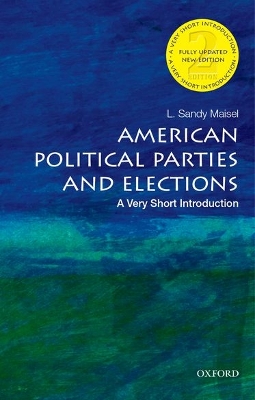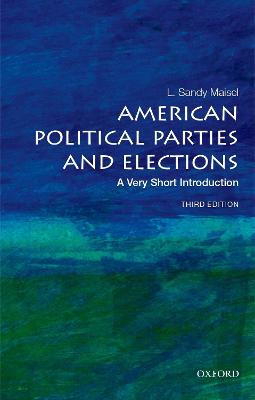Very Short Introductions
2 total works
American Political Parties and Elections: A Very Short Introduction
by L. Sandy Maisel
Published 1 July 2007
Few Americans and even fewer citizens of other nations understand the electoral process in the United States. Still fewer understand the role played by political parties in the electoral process or the ironies within the system. Participation in elections in the United States is much lower than in the vast majority of mature democracies. Perhaps this is because of the lack of competition in a country where only two parties have a true chance of winning, despite the
fact that a large number of citizens claim allegiance to neither and think badly of both. Or perhaps it is because in the U.S. campaign contributions disproportionately favor incumbents in most legislative elections, or that largely unregulated groups such as the now notorious 527s have as much impact
on the outcome of a campaign as do the parties or the candidates' campaign organizations. These factors offer a very clear picture of the problems that underlay our much trumpeted electoral system.
The second edition of this Very Short Introduction introduces the reader to these issues and more. Drawing on updated data and new examples from the 2016 presidential nominations, L. Sandy Maisel provides an insider's view of how the system actually works while shining a light on some of its flaws. He also illustrates the growing impact of campaigning through social media, the changes in campaign financing wrought by the Supreme Court recent decisions, and the Tea Party's influence on
the sub-presidential nominating process. As the United States enter what is sure to be yet another highly contested election year, it is more important than ever that Americans take the time to learn the system that puts so many in power.
fact that a large number of citizens claim allegiance to neither and think badly of both. Or perhaps it is because in the U.S. campaign contributions disproportionately favor incumbents in most legislative elections, or that largely unregulated groups such as the now notorious 527s have as much impact
on the outcome of a campaign as do the parties or the candidates' campaign organizations. These factors offer a very clear picture of the problems that underlay our much trumpeted electoral system.
The second edition of this Very Short Introduction introduces the reader to these issues and more. Drawing on updated data and new examples from the 2016 presidential nominations, L. Sandy Maisel provides an insider's view of how the system actually works while shining a light on some of its flaws. He also illustrates the growing impact of campaigning through social media, the changes in campaign financing wrought by the Supreme Court recent decisions, and the Tea Party's influence on
the sub-presidential nominating process. As the United States enter what is sure to be yet another highly contested election year, it is more important than ever that Americans take the time to learn the system that puts so many in power.
American Political Parties and Elections: A Very Short Introduction
by L. Sandy Maisel
Published 28 July 2022
Few Americans and even fewer citizens of other nations understand the electoral process in the United States. Still fewer understand the role played by political parties in the electoral process or the ironies within the system. Participation in elections in the United States is much lower than in the vast majority of mature democracies. Perhaps this is because of the lack of competition in a country where only two parties have a true chance of winning, despite the
fact that a large number of citizens claim allegiance to neither and think badly of both. Or perhaps it is because in the U.S. campaign contributions disproportionately favor incumbents in most legislative elections, or that largely unregulated groups such as the now notorious 527 organizations have
as much impact on the outcome of a campaign as do the parties or the candidates' campaigns. For instance, in two of the last six presidential elections, the winner of the popular vote lost the election in the Electoral College; in two others, a change of fewer than 100,000 votes in selected states would have led to the same result. These factors offer a very clear picture of the problems that underlie our much trumpeted electoral system.
The third edition of this Very Short Introduction analyzes these issues and more. Accounting for changes in electoral coalitions and the extent to which the American electorate is polarized in the wake of Donald Trump, L. Sandy Maisel explains how the system actually works while shining a light on some of its flaws. He also looks closely at turnout questions; efforts both to ease access to the ballot in some states and to restrict access in others; and the role of social media in
campaign strategy.
fact that a large number of citizens claim allegiance to neither and think badly of both. Or perhaps it is because in the U.S. campaign contributions disproportionately favor incumbents in most legislative elections, or that largely unregulated groups such as the now notorious 527 organizations have
as much impact on the outcome of a campaign as do the parties or the candidates' campaigns. For instance, in two of the last six presidential elections, the winner of the popular vote lost the election in the Electoral College; in two others, a change of fewer than 100,000 votes in selected states would have led to the same result. These factors offer a very clear picture of the problems that underlie our much trumpeted electoral system.
The third edition of this Very Short Introduction analyzes these issues and more. Accounting for changes in electoral coalitions and the extent to which the American electorate is polarized in the wake of Donald Trump, L. Sandy Maisel explains how the system actually works while shining a light on some of its flaws. He also looks closely at turnout questions; efforts both to ease access to the ballot in some states and to restrict access in others; and the role of social media in
campaign strategy.

